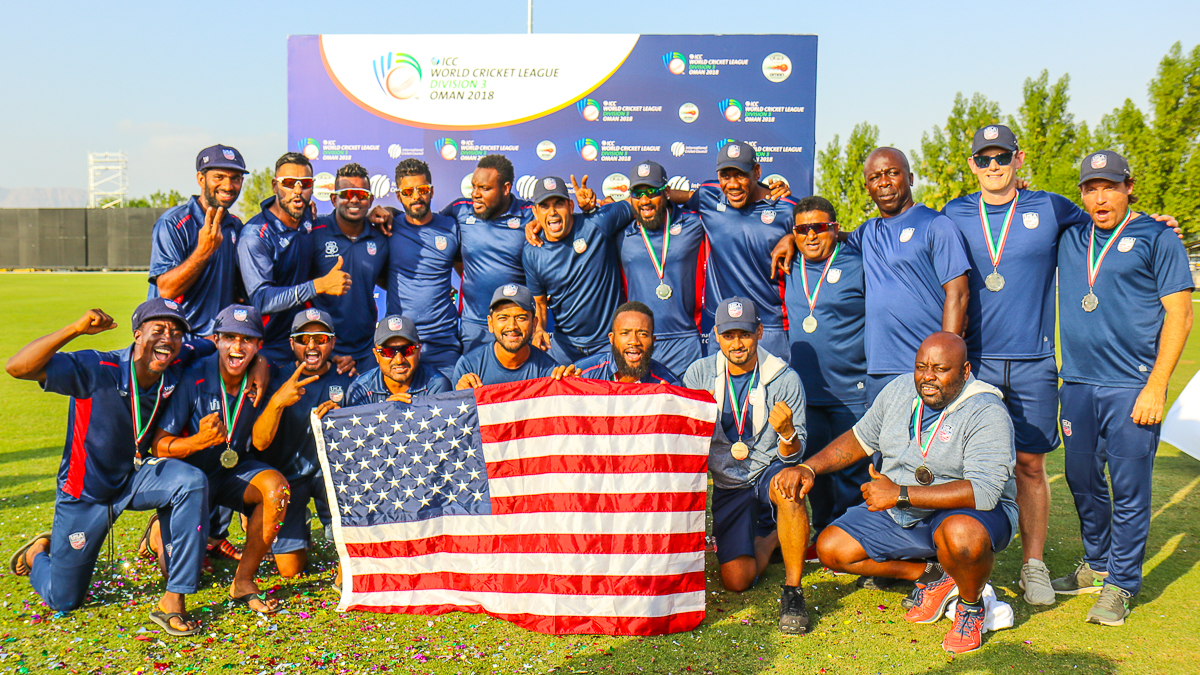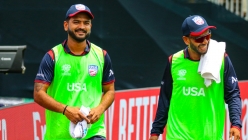USA Cricket: 2018 WCL Division 3 Tour Report Card – Team Grades
2018 Nov 21 by DreamCricket USA

It's time once again for DreamCricket's traditional report card review of USA's collective and individual fortunes at WCL Division Three in Oman. First up are the team grades featuring category reviews in USA's batting, bowling, fielding and fitness while on tour.
Photo credit: Peter Della Penna
By Peter Della Penna
Batting grade: B-
On paper, USA’s batting lineup scored the second most runs in the tournament. However, this was largely a function of batting first in four of the five matches they played whereas Oman for example batted last in all five matches, routinely holding their opponents to well below par totals on the way to going undefeated.
Taking a closer look on a player-by-player basis, USA’s lineup was very inconsistent with the exception of Aaron Jones and Hayden Walsh Jr. Aside from the Barbados-based pair, there were only four 50+ scores for the rest of the team in Oman. Barring the first match against Uganda in which Monank Patel scored a century, USA’s top-order regularly failed.
Four of the five best partnerships for USA during the tournament were by either the fifth or sixth-wicket partnership and Walsh featured in three of those such partnerships, including USA’s best of 131 for the sixth wicket against Denmark. That sixth-wicket stand between Walsh and Jones was not just huge in the context of the match, rescuing USA from 87 for 5 after 26 overs when they were floundering against Denmark’s spinners, but it was also a historic partnership.
The 131-run stand between Walsh and Jones set a new record as USA’s best ever sixth-wicket stand in one-day cricket, breaking the previous record which had been held by Aditya Thyagarajan and Rashard Marshall with a 119-run stand against Bermuda at Florida in 2008. Keep in mind that was when Bermuda was actually a force to be reckoned with just a year removed from playing in the 2007 World Cup and not the current incarnation of Bermuda which has fallen down the rankings to WCL Division Five and will be one of the lowest ranked teams participating in the Cricket World Cup Challenge League starting in 2019.
Aside from that century stand between Walsh and Jones against Denmark, USA had six half-century stands. Monank Patel was one of three century-makers during the tournament as well, which deserves to be recognized especially as it came in the opening match to give USA an early momentum boost. Jones, Monank and Walsh finished fourth, fifth, and sixth respectively on the scoring leaderboard at the end of the tournament.
USA’s running between the wickets at times showcased their unfamiliarity with each others’ styles considering so many new players have entered the team since September. USA’s batsmen were runout six times during the tournament. Three of those were in the final overs when they were chasing quick runs, including one on the final ball of the innings v Oman, but at least three were simply down to poor communication and understanding between partners.
USA also escaped four other clear runout chances (Monank on 2 v Uganda, made 107; Taylor on 12 v Kenya, made 41; Jones on 19 v Kenya, made 69; Timil on 11 v Oman, made 54) that would have had a dramatic impact on match results had they been converted. USA gained 217 unearned runs from those missed opportunities and that doesn’t even include other runs USA profited from as a result of dropped catches. Adding eight more drops by opponents in the field, USA gained a whopping 290 runs from missed chances, averaging 32.22 runs after the first chance missed until they were dismissed, if at all. There were also at least a half-dozen other close shaves between the wickets as a result of miscommunication between partners.
Overall, USA’s team batting was decent, but not spectacular. They’ll need to be much sharper as a unit to have a chance of finishing in the top four in Namibia next April where they will be coming up against a far more competitive tournament field that includes Canada, Hong Kong, Namibia, Oman and Papua New Guinea.
Bowling grade: A-
In reality, it was USA’s bowlers that won them this tournament far more than the batting did. On pitches that were generally conducive to good batting, USA’s bowlers stepped up in a big way. Ali Khan and Saurabh Netravalkar claimed Man of the Match honors against Kenya and Singapore respectively for impressive three-wicket hauls, Ali Khan with the new ball against Kenya and Netravalkar coming back in a late spell to wipe out Singapore. Overall, the bowlers claimed 42 out of a possible 50 wickets, with three others coming via runouts.
USA’s leading wicket-taker Timil Patel didn’t claim any Man of the Match honors but was consistently USA’s most potent threat, a stunning comeback performance for the legspinner after it looked like his match-winning talent was in decline during the T20 Qualifier in North Carolina two months earlier. He claimed 11 wickets at an average of 10.72 and an economy rate of just 2.95, leading USA in all three categories.
Walsh also performed admirably with the ball in key situations taking seven wickets to finish third on the team at Division Three behind Timil and Netravalkar. He also nearly spun USA to victory at the death against Oman and there’s a high probability he would have had he been better supported in the field.
As for opposition partnerships, USA only allowed five 50+ stands during the tournament, two each against Oman and Uganda as well as one against Denmark with a best of 94 for the second wicket by Jatinder Singh and Aqib Ilyas of Oman, a partnership that went a long way towards Oman chasing successfully in a four-wicket win. With the exception of the Oman match in particular, USA’s bowlers did an efficient job in terms of making regular breakthroughs in order to deny their opposition opportunities at building momentum.
On the whole, USA’s bowling unit was the second best at the tournament behind champions Oman and is geared to put in another solid display at Division Two.
Fielding grade: B
USA’s fielding in the ring was a lot tighter than it had been in prior tournaments. The three runouts USA completed in the field were all direct hits off of sensational individual efforts.
It started with Steven Taylor charging in from backward point with an underhand flick from eight yards to get Uganda’s Arnold Otwani, who was on 52 at the time, to spark a Ugandan collapse. The second was Ali Khan’s direct hit from 35 yards out on the long-off boundary to get Nicolaj Laegsgaard of Denmark in the 49th over of their chase, crucial because he was the last player capable of clearing the boundary in USA’s 16-run win.
Last was Hayden Walsh’s brilliant knock down off his own bowling and then flick into the stumps from three yards in the 49th over against Oman that nearly sparked a dramatic collapse. Special mention should go to Jaskaran Malhotra’s outstanding effort to scoop a cut shot off a short hop before breaking the bails to get the dangerous Singapore captain Chetan Suryawanshi, which officially was credited as a stumping instead of a runout even though Suryawanshi had chopped the ball into the ground and set off for a run.
However, USA arguably cost themselves a win against Oman by faltering badly in the fielding department in that match. Malhotra blew two runout chances in the final four overs, first with a poorly rushed relay to the bowler’s end when Zeeshan Maqsood was on 26 only to have Maqsood get on strike and smash Walsh for a six a few balls later that was pivotal in the final result, and then in the 49th when he failed to properly collect a one-bounce relay by Ali Khan from the boundary with Sufyan Mehmood four yards short of making his ground.
Monank dropped Maqsood at backward point on 15 in the 41st over before he ended on 32 and then had another bad drop at midwicket on the final ball of the 49th over to new batsman Nester Dhamba's second ball, who took a single off it to get off the mark and proceeded to strike Ali Khan’s first ball of the 50th over over backward point for 4 to take Oman’s equation down to 2 off 5 balls, followed by two more singles for the win.
In all, USA’s missed a total of 12 chances in the field: seven dropped chances (three by Monank, two by Malhotra, one by Jones, one by Roy Silva) and five missed runout chances (one poor throw and one fumbled collection by Malhotra, both against Oman; one poor throw by Taylor that pulled Malhotra away from the stumps against Singapore; Jannisar Khan throwing to the wrong end when both batsmen were at the same end against Denmark; and one by Walsh against Denmark that not only missed the stumps but went for 5 overthrows).
This also doesn’t include some questionable tactical decisions that arguably cost USA runs as well, such as when Timil Patel came on against Oman without a slip and induced two edges through vacant slip which could have cut short the innings of both Jatinder Singh and Aqib Ilyas long before they took the match away from USA.
The missed chances cost USA 136 runs at an average of 17.00 runs after the first missed chance before a batsman was dismissed. Balancing that against the 290 runs USA gained from missed chances by their opponents in the field when USA was batting, USA came out with a +154 run net fielding differential in the end, not including misfields along the ground by USA or their opponents. Simply put, it shows that the mistakes they made were not nearly as costly as the ones made by their opponents, in part because USA continued to apply pressure until a subsequent opportunity presented itself in the field either through a bowler creating a chance or a fielder denying runs and creating a chance along the ground.
On a positive note, Steven Taylor’s slip-catching was outstanding while Malhotra pulled off some remarkable catches behind the stumps as well, ending with 11 total dismissals in Oman, second in the tournament. Walsh was the all-round standout in the field though by some distance starting with his footspeed to the ball at backward point and extra cover which saved countless runs. Add that to his superb runout against Oman off his own bowling and three catches, including two outstanding diving efforts at extra cover against Singapore to fetch two wickets for Netravalkar and it was hard not to notice the impact he had on USA's collective fielding performance, which was way better than what they showed during some shocking performances during the World T20 Subregional Americas Qualifier in North Carolina without Walsh just two months earlier.
Fitness grade: C+
This is a quirky one to grade. USA’s fitness appeared better than it has been at prior tournaments with players generally appearing fresh on the field. However, this was also a function of USA testing lax enforcement by the ICC umpires regarding substitute fielding allowances with near constant use of subs.
By an overwhelming distance, no other team came even remotely close to having substitute fielders on the field as much as USA did throughout the tournament. The regularity with which USA flaunted their use of substitute fielders would have made the England teams in the Duncan Fletcher era blush.
The USA carousel of substitute fielders was so egregious during the opening match against Uganda – at least five USA players went off the field at some stage of the second innings for what appeared to simply be comfort breaks – that the third umpire from the ICC actually walked into USA’s change room at one stage around the 34-over mark to physically bring Monank Patel back out onto the field of play, dismissing the USA staff’s claims that he was dealing with a back issue. Monank fielded the rest of the match without much fuss and USA went the final 16 overs without using any more substitute fielders.
The recurring theme was that anyone who scored runs in the first innings didn’t have to come out and field right away in the second. Aside from Monank, who spent lengthy spells off the field after scoring a century against Uganda, Aaron Jones also started the early part of the innings off the field against Denmark after having just scored 78 while Jannisar Khan spent the entire innings off the field against Oman after he had just scored 53 in a late surge at the end of the first innings.
USA struggled badly in the field against Denmark with several players including Monank and Walsh cramping up early in the Denmark chase and needed to leave the field for rehydration, which was quite surprising considering USA had just had two straight off days and it was only their third match of the tournament. It nearly cost them in what was a closely contested 16-run win for USA in the end. USA's historically poor record on the fourth match day of WCL events continued in Oman as they lost to the hosts on a day where it appeared their dwindling energy levels due to average fitness caught up with them. The fourth match day at the WCL is generally the second of back-to-back matches but in this instance was the only back-to-back match USA had and yet they struggled anyway.
With the loss to Oman in Oman, USA is now 1-9 all time on the fourth match day of WCL tournaments. The only time they have won on that second back-to-back match day or fourth match day was against Oman in 2011 WCL Division Three at Hong Kong. They were quite fresh that day considering the fact that they were bowled out for 44 in just 20.2 overs a day earlier by Papua New Guinea followed by a chase that lasted just six overs. It meant that USA was on the field for 26.2 overs out of 100, or less than two hours of play instead of seven, and they were plenty fresh to take on Oman the next day compared to how exhausted they have appeared in all other instances.
Once again, fitness will need to be improved for WCL Division Two in Namibia. That tournament will revert to the traditional WCL format of six matches in eight days because the host site has three grounds allowing for three matches to be played simultaneously unlike Oman’s two grounds which meant staggered off days for teams.
The slight format switch for Oman resulted in USA playing five matches spread across ten days, including two sets of sequences where USA had two consecutive off days between matches instead of one. No other team has demonstrated such a historic struggle with their fitness as USA has on back-to-back match days and that will be a serious test for them to overcome when the tournament gets underway in April.




